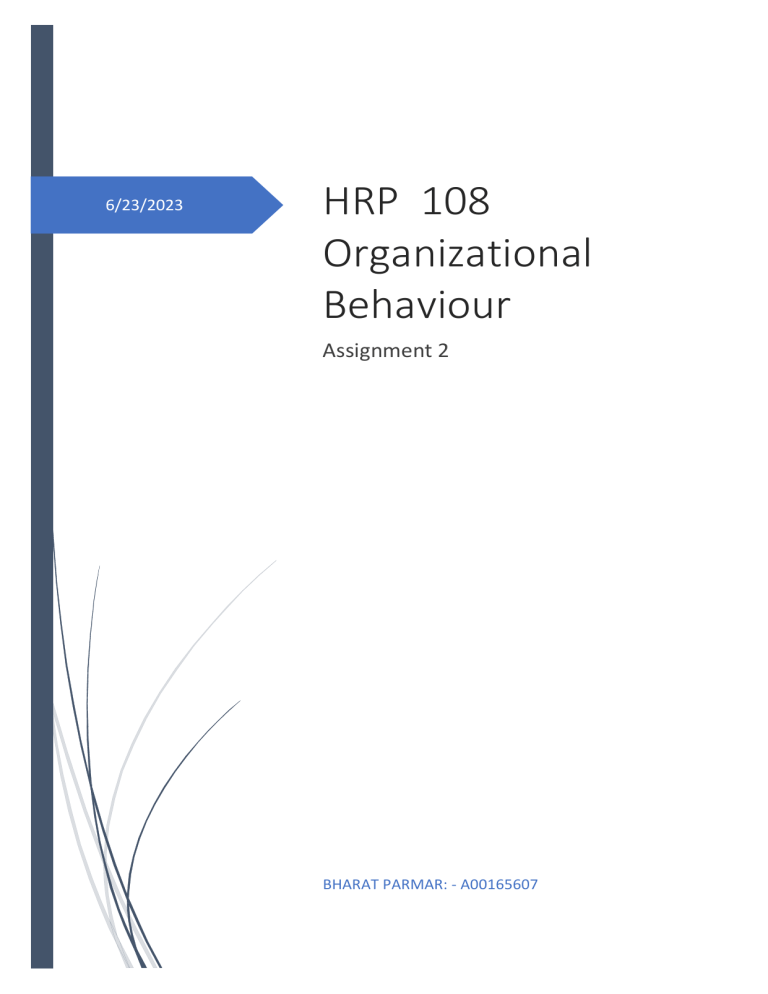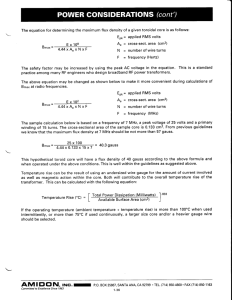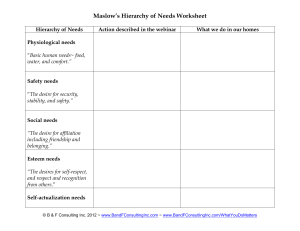
6/23/2023 HRP 108 Organizational Behaviour Assignment 2 BHARAT PARMAR: - A00165607 HRP 108 Organizational Behaviour June 2023 By: Professor: Kassandra Wagner CANADORE COLLEGE BHARAT PARMAR - A00165607 1. Explain one of your dominant personality values in reference to Schwartz’s Value Model or Circumflex (Chapter 2 - Week 2). Explain why this value would either positively or negatively affect your performance as a transformational leader and provide examples. Answer: Success is one of my core identity values, which aligns with Schwartz's Esteem Demonstrate. Achievement conveys a person's desire for success, competence, and the achievement of significant goals. As a transformational leader, this regard can significantly influence my performance by inspiring and motivating others to go above and beyond, establishing clear goals, and fostering a climate of continuous improvement. The value of success motivates me to set high standards for excellence in both my professional and personal endeavours. I can inspire my team members to exceed their expectations by clearly communicating my high standards to them as a transformational leader. I can promote a culture of achievement and continuous learning within the team by promoting a growth mindset and highlighting the importance of hard work and perseverance. Furthermore, by encouraging innovation and creativity, the value of achievement can favourably affect my leadership style. It motivates me to look for new opportunities and push boundaries, inspiring my team to take novel approaches and think outside the box. This may result in ground-breaking ideas and improved organizational performance. It's crucial to remember that, if not properly balanced, the value of achievement can have unfavourable effects. For instance, putting too much emphasis on one's success may result in neglecting the growth and welfare of the team. Striking a balance between your growth and that of others is essential for transformational leaders. Mentoring, recognizing and rewarding team accomplishments, and fostering a collaborative environment can all help with this. In conclusion, the value of achievement, which is a dominant personality value, has a positive effect on how well I perform as a transformational leader by igniting motivation, fostering innovation, and encouraging continuous improvement. To develop a healthy and long-lasting leadership style, it is crucial to make sure that this value is balanced with the growth and well-being of the team. 2. Expectancy theory describes E-P and P-O. Reflect on how you prepared for this program in the week before the semester started. Explain two ways that you increased the E-P expectancies for success for in the Human Resources Management Program at Canadore College. Answer: I took a number of actions as a student getting ready for Canadore College's Human Resources Management Program to raise my E-P (effort-performance) expectations for success. According to expectation theory, people are motivated to put forth effort when they think it will result in successful performance. Before the semester began, I improved my E-P expectations in the following two ways: A) Conducting Research and Seeking Information: I proactively looked into the Canadore College Human Resources Management Programme to raise my E-P expectations. I looked over the course descriptions, curriculum, and learning objectives for the programme. I gained a clear understanding of what was necessary to succeed academically by understanding the programme's prerequisites and expectations. By matching my expectations with the programme's goals thanks to this research, I was better able to believe that my efforts would result in a successful performance. I also got in touch with programme alumni or current students to get their insights on how to succeed in particular courses and assignments. Their knowledge and suggestions helped me learn useful information and increased my faith in my capacity to do well. B) Setting Realistic Goals and Developing Action Plans: Making realistic goal and action plan sets was another way I improved my E-P expectations. I set clear academic goals for each course, like attaining a certain GPA or understanding fundamental HR principles. I created actionable steps that would contribute to my overall success by breaking these goals down into more manageable, smaller tasks. For instance, I created a study schedule, set aside time specifically for coursework, and identified resources like books, online resources, or study groups to aid my learning. These action plans strengthened my conviction that the hard work I put in would pay off by enabling me to see the relationship between my actions and anticipated performance outcomes. I raised my E-P expectations for success in the Canadore College Human Resources Management Program by conducting in-depth research, looking for information, setting attainable goals, and developing action plans. These proactive steps enabled me to match my efforts with the anticipated performance results, which increased my motivation and faith in my capacity to achieve academic success. 3. The Four-Drive Theory suggests that companies must keep fulfilment of the four drives in balance. What is this balance and why is it important? Give an example either real or hypothetical of how a company maintains balanced fulfilment. Answer: According to Lawrence and Nohria's Four-Drive Theory, people are motivated by four basic emotional and biological needs: the need to acquire, form bonds with others, understand, and defend themselves. These motivations affect how people behave and can also be used in organizations. Companies must strike a balance in achieving these goals if they want to increase employee motivation, engagement, and general wellbeing. Organizations should work to address the demands connected with each drive in a harmonic and integrated way in order to achieve the balance in fulfilling the four drives. Employee discontent, lower productivity, and high turnover can result from undervaluing or overemphasizing any one driving. For instance, if a business only prioritizes gratifying the drive to acquire by providing large cash rewards while ignoring the drive to bond or cultivate a sense of belonging, employees may feel alone and unmotivated despite the financial advantages. An IT business that prioritizes employee well-being is an example of a company that maintains a balanced fulfilment of the four drivers. In order to ensure that workers are adequately rewarded for their efforts, the firm offers competitive pay and performance-based incentives in recognition of the desire to acquire. The organization also places a strong emphasis on the desire to connect by fostering an inclusive and friendly work atmosphere and encouraging teamwork and collaboration through team-building exercises and social gatherings. Additionally, the business recognizes the desire to comprehend by offering chances for career advancement. They encourage staff members to embark on difficult initiatives that advance their learning and skill development by providing training programs, mentorship opportunities, and training opportunities. The organization also prioritizes work-life balance, supports a positive workplace culture, and offers tools for stress management to combat the desire to defend. They design rules that support employee well-being, encourage frequent breaks, and offer flexible work schedules. This fictitious corporation fosters a work atmosphere that fosters employee motivation, engagement, and pleasure by keeping a balance in achieving the four drives. Increased productivity, creativity, and loyalty result from employees feeling appreciated, engaged, challenged, and supported. In conclusion, businesses must strike a balance between the four motivations to foster an atmosphere that encourages employee engagement and well-being. Organizations may foster a healthy workplace culture and raise overall employee happiness by identifying and fulfilling the requirements connected to each drive. 4. Which drive from the Four-Drive Theory do you associate with most when doing teamwork or group activities? How does this drive influence your behaviour and motivation? Answer: I most frequently link the urge to bond from the Four-Drive Theory with cooperation or group activities. The craving for meaningful relationships, social connection, and belonging is referred to as the "drive to link." This desire significantly affects my attitude and drive in a group context. The need to connect motivates me to actively interact with team members, promote a feeling of camaraderie, and create solid professional relationships because I value cooperation and interpersonal ties. I place a high value on fostering open communication, trust, and a welcoming environment among my team members. I think a team that works well together and feels connected to one another would perform better overall. This motivation affects my behaviour by encouraging teamwork and collaboration. I aggressively seek out chances to participate in team-building events, promote open communication, and foster a culture of mutual respect and support. I value each team member's thoughts and opinions, acknowledging the relevance of varied perspectives in developing new solutions. Furthermore, the desire to bond boosts my motivation by creating a sense of belonging and a common goal. When I detect a strong feeling of camaraderie among my team members, it drives my excitement, dedication, and inner motivation to provide my best efforts. Working together to achieve a common objective and feeling a sense of communal success increases my drive and enjoyment. A group project at university is an example of how the need to bond affects my behaviour and motivation in a team context. I organized frequent team meetings to encourage communication and collaboration among group members. I encouraged everyone to express their ideas, actively listened to their points of view, and made sure that everyone on the team felt respected and included. We built a friendly and trustworthy environment in which everyone felt safe expressing their thoughts and taking chances through developing strong interpersonal ties. As a consequence, the team was extremely engaged and driven, resulting in a good project outcome. In conclusion, the desire to bond has a big effect on my behaviour and motivation in team situations. I seek to establish a collaborative and supportive team atmosphere by promoting social connection, relationship development, and developing a feeling of belonging. This desire boosts my motivation, encourages teamwork, and helps the team's overall success.



